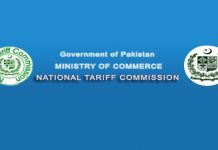There’s no exportable surplus.
That is the typical response you get from private sector and policy makers alike when you ask why Pakistani exports don’t increase when the rupee weakens. In other words, what Pakistan can export, it is already exporting. If prices improve, then exporters will make more money, but will not expand much. This reasoning is hard to accept, given that just a year ago we estimated the country’s export potential at US$88 billion—far more than it is currently exporting. The “missing” export surplus is close to US$60 billion!
On June 15, the Fed increased rates by 75 basis points from 1 to 1.75 percent. Add to that, commodity prices are at record highs. The combination means that many developing economies like Pakistan face increasingly large import bills, scarcer external finance, and pressure on their currencies. Indeed, the PKR/USD parity hit a maximum of 210 on June 20, up from 185 only two months before.
As economists, we are used to drawing an automatic link between (real) exchange rates and exports. If you export recycled cotton towels at $1 per piece, the weakening rupee means 25 additional rupees per dollar exported today than two months ago. Because a chunk of your costs is fixed in rupees – say, the salaries of your workers, depreciations boost your profits, you’ll try to sell as many towels as possible – perhaps hire a few additional workers to scale up, or even re-orient some of your domestic sales into export markets.
We are also used to assuming a symmetric link. Exports increase with (real) currency depreciations and fall with (real) appreciations in the same way. But this may not always be the case.
In a new paper with Martin Brun and Juan Gambetta, we tackle this question of if and why export responses to real exchange depreciations are lower than those to appreciations.
We first use macro-level data to understand the nature of the link between exchange rates and exports in Pakistan. We find that, contrary to the conventional (Pakistani) wisdom, exports do respond to depreciations (and appreciations) in the long run. A 10 percent real depreciation increases exports by 4.9 percent over a two-year period. Yet, and somehow validating that conventional wisdom, the speed at which exports adjust to the ‘new normal’ after a depreciation is only one-third as fast as the adjustment after an appreciation. Exports fall faster after (real) appreciations than they increase after depreciations.
The natural follow up question is why. We rely on product-destination level export data and examine three complementary explanations: information frictions, supply constraints, and pricing to market.
First, information frictions increase the costs of finding new clients and make losing clients after appreciations easier than getting new ones after depreciations. To test this hypothesis, we exploit the fact that information frictions affect differentiated products more than homogenous ones: finding a client to buy more t-shirts requires agreeing on design, sizes, or pricing. Instead, if you are selling basmati rice, product specifications tend to be pre-defined and reference prices made public through organized exchanges. Our results back this up. For differentiated goods, export responses to depreciations are 27 percent lower than to appreciations, while there is no difference for homogenous goods. Thus, the value of export promotion in reducing the costs of searching for new clients increases after depreciations.
Second, the “no exportable surplus” story is a supply constraints argument. If you were exporting recycled cotton towels and the rupee depreciated, you’d now get more rupees per towel. But scaling up takes financing for that extra machine to recycle the yarn, and the plant expansion.
We examine the extent to which these supply constraints explain the limited export response to depreciations, exploiting differences in sectors’ access to credit. We find that Credit and export responses to depreciations are complementary because credit facilitates scaling up. But it’s possible that sectors that access more credit are special for reasons other than credit, and that’s why they also respond faster to depreciations. This is why we also relied on two largely exogenous export supply constraint variables: factor intensity and external finance dependence. We find that more labor-intensive sectors and those that are structurally less external-finance dependent show higher sensitivities to real exchange rate depreciations. Taken together, these results point to supply constraints in impeding export responses to depreciations.
Third, we examine if pricing to markets also explains the asymmetry. If Pakistani exporters are small relative to global buyers and have limited bargaining power, buyers could negotiate lower dollar-prices after the rupee depreciates, thus eating up the exporters’ margins. This is what Pakistani textile and apparel exporters told us when we interviewed them and asked them why they did not scale up exports after the depreciation of the rupee in 2018/19. Part of the benefit was passed to foreign buyers. We test this hypothesis by analyzing differences in exporting prices by selling destination. We find that adjustments in profit margins stabilize export prices in the domestic currency, and this is amplified during depreciations: US dollar export prices react to nominal exchange rate changes by 15 percent more than in appreciations. This asymmetric response of export US dollar prices becomes more pronounced the larger the change in the exchange rate, suggesting that buyers smoothen prices in Pakistani rupees.
While the focus of this analysis is Pakistan, it likely that these results are also valid in other countries at a similar level of development. Policymakers should take stock of these findings and ensure the enabling environment for a maximized export response to currency depreciations.
“Reproduced with permission from Trade Post.”
























What exactly does “export potential” mean? and how is it calculated?
Can somebody please explain